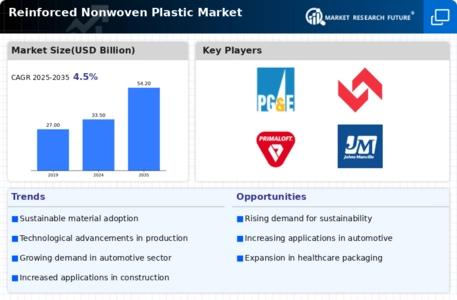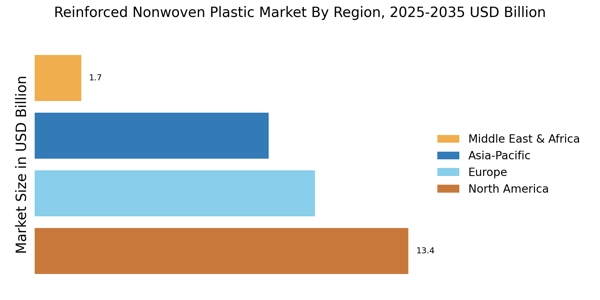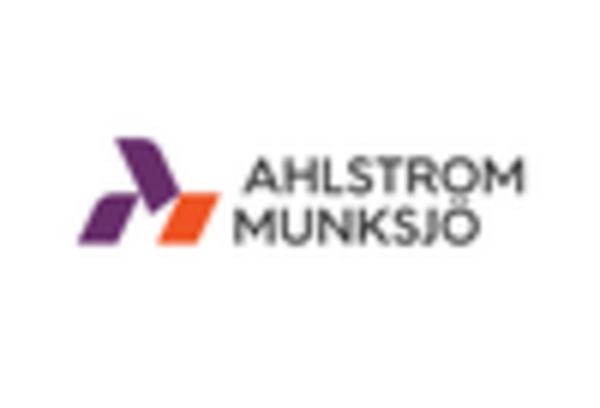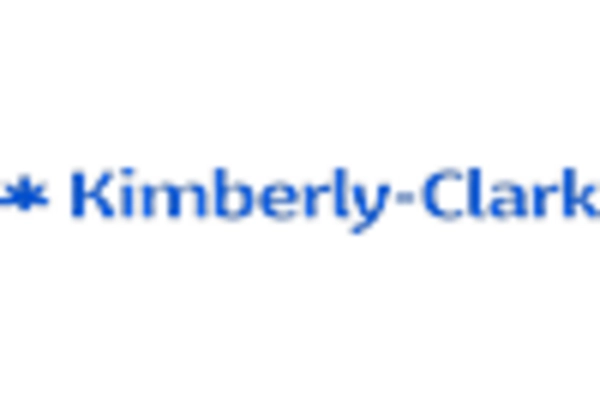Regulatory Support
Regulatory support for the use of nonwoven materials is emerging as a significant driver for the Reinforced Nonwoven Plastic Market. Governments are increasingly implementing regulations that promote the use of sustainable materials in various applications, particularly in packaging and construction. This regulatory environment encourages manufacturers to adopt reinforced nonwoven plastics, which are often more compliant with environmental standards. For instance, certain regions have introduced incentives for companies that utilize eco-friendly materials, potentially increasing the market share of reinforced nonwoven plastics. As these regulations evolve, the Reinforced Nonwoven Plastic Market is likely to benefit from enhanced demand driven by compliance and sustainability initiatives.
Consumer Preferences
Shifting consumer preferences towards lightweight and durable materials are driving growth in the Reinforced Nonwoven Plastic Market. As consumers become more discerning about the products they purchase, there is a noticeable trend towards materials that offer both functionality and sustainability. Reinforced nonwoven plastics, known for their lightweight nature and strength, are increasingly favored in sectors such as packaging and automotive. Market data indicates that consumer demand for lightweight packaging solutions is expected to rise by approximately 7% annually, further propelling the adoption of reinforced nonwoven plastics. This shift in consumer behavior suggests that the Reinforced Nonwoven Plastic Market will continue to thrive as manufacturers adapt to these evolving preferences.
Diverse Applications
The versatility of reinforced nonwoven plastics is a crucial driver for the Reinforced Nonwoven Plastic Market. These materials are increasingly being utilized in a variety of applications, ranging from geotextiles in civil engineering to medical textiles in healthcare. The ability to customize the properties of reinforced nonwoven plastics allows for their use in specialized applications, which is particularly appealing to manufacturers seeking to differentiate their products. Market analysis indicates that the construction sector alone accounts for approximately 30% of the total demand for reinforced nonwoven plastics, highlighting the material's importance in various industries. This trend suggests that the Reinforced Nonwoven Plastic Market will continue to expand as new applications are discovered and developed.
Sustainability Initiatives
The increasing emphasis on sustainability appears to be a pivotal driver for the Reinforced Nonwoven Plastic Market. As consumers and businesses alike become more environmentally conscious, there is a growing demand for materials that are not only durable but also eco-friendly. Reinforced nonwoven plastics, which can be produced from recycled materials, align well with these sustainability goals. This shift is reflected in market data, indicating that the demand for sustainable packaging solutions is projected to grow at a compound annual growth rate of approximately 5% over the next five years. Consequently, manufacturers in the Reinforced Nonwoven Plastic Market are likely to invest in sustainable practices, thereby enhancing their market position and meeting consumer expectations.
Technological Advancements
Technological advancements in manufacturing processes are significantly influencing the Reinforced Nonwoven Plastic Market. Innovations such as improved bonding techniques and the development of high-performance fibers are enhancing the properties of reinforced nonwoven plastics. These advancements not only improve the strength and durability of the materials but also expand their applicability across various sectors, including automotive, construction, and healthcare. Market data suggests that the integration of advanced technologies could lead to a reduction in production costs by up to 15%, making these materials more accessible to a broader range of industries. As a result, the Reinforced Nonwoven Plastic Market is poised for growth as manufacturers adopt these cutting-edge technologies.


















Leave a Comment